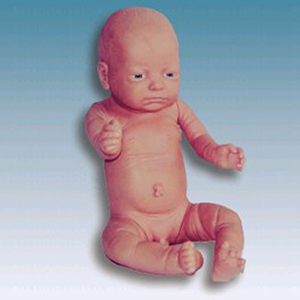
Can full-term baby models provide a more realistic clinical context for first aid training?
Article tag: Full-term infant model Medical Pediatric model BIX-LF1

In short, the full-term baby model can not only provide real clinical scenes in teaching, but also improve the students' emergency handling ability and technical accuracy through repeated simulation training, providing a strong guarantee for the success of neonatal first aid.
...
In medical education, simulation training has become one of the core means to improve first-aid skills. For neonatal emergency care, the use of full-term baby models is gaining increasing attention because it can provide a training experience that is closer to a real clinical context than traditional methods. This paper will explore whether the full-term baby model can provide a more realistic clinical context for first aid training and support its importance in medical education with relevant data.
The clinical importance of a full-term infant model

First aid for newborns, especially in the care of full-term infants, often requires a quick and accurate response. This not only requires first responders to have a solid theoretical knowledge, but also requires them to be able to respond quickly in real situations. However, due to the special physiological structure of newborn, the traditional first-aid training model often can not completely simulate the physiological response and clinical situation of newborn.
Full-term baby models are different. Through the fine physiological structure design, it can simulate the real physical characteristics of infants, such as body size, skin tension, breathing and heartbeat, and provide students with a more realistic operating environment. This highly simulated training platform not only enhances the training effect, but also effectively improves the emergency personnel's response ability in real situations.
Clinical context provided by a full-term infant model
1. Real physiological structure and response
A full-term baby model is often designed with a size, weight, and anatomy close to that of a real baby, allowing trainees to feel a response similar to a real clinical situation when performing operations such as airway management, resuscitation, cardiopulmonary resuscitation (CPR), oxygen supply, and more. For example, the model's chest can be compressed to simulate the lung response during artificial respiration, and the simulator can have pulse, breathing and body temperature feedback consistent with that of a real baby.
This highly simulated training environment helps students quickly adapt to the physiological characteristics of real babies in clinical operations, and improves the accuracy of the execution of first aid measures.
2. Emergency response ability training
During a newborn emergency, the doctor or nurse must make a quick judgment and take appropriate action. The full-term baby model helps students develop the ability to react quickly by simulating different emergency situations, such as respiratory distress, suffocation, cardiac arrest, etc. Through repeated training, students can not only master the first aid process, but also keep calm under pressure and improve their ability to deal with emergencies.
3. Clinical decision and technology application
In first aid, especially when it comes to airway management and medication use, accurate handling skills are essential. The full-term baby model allows students to continuously improve the technical accuracy in repeated exercises, such as tracheal intubation, chest compression, drug administration and other operations. Based on model feedback, students are able to clearly grasp the details of each step and reduce errors in clinical operations.
Data support: Effect of full-term infant model
According to one study, participants who trained in neonatal first aid using a full-term baby model were about 30% more accurate in real first aid scenarios than participants who did not use simulation training. In addition, another study involving neonatal resuscitation techniques showed that after training through the simulator, the success rate of resuscitation was increased by 50% and the time to deal with infant suffocation was reduced by 25%.
These data show that the full-term baby model can effectively improve the trainees' operational skills in first-aid training, especially the judgment and operation speed in newborn emergency situations.
Conclusion: The value of training in real clinical situations
The full-term baby model helps trainees improve their operational proficiency and emergency response ability in a stressful first aid environment by providing a more realistic clinical situation. Compared with traditional training methods, the model can simulate complex first aid situations and provide rich training scenarios, so that students can respond more accurately and quickly in actual operation. Based on the available data and research, the full-term baby model is undoubtedly an effective tool to improve neonatal first-aid skills, and is an indispensable training device for medical students and clinical staff.
In short, the full-term baby model can not only provide real clinical scenes in teaching, but also improve the students' emergency handling ability and technical accuracy through repeated simulation training, providing a strong guarantee for the success of neonatal first aid.

Marketing Center
Hong Kong, ChinaProduction Base
Shanghai, ChinaProducts
Contact Us
 Address: Hong Kong, China
Address: Hong Kong, China
 Phone:+86 19937901373
Phone:+86 19937901373
 Email:sophia@adahealthy.com
Email:sophia@adahealthy.com
 Mobile:+86-0379-65160607
Mobile:+86-0379-65160607








